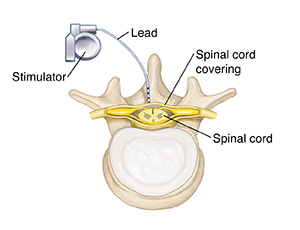Spinal Cord Stimulation
Pain messages travel over nerve pathways to the spinal cord, inside the spine. The spinal cord carries the messages to the brain. Constant pain messages can cause long-term pain that's hard to treat. This is called chronic pain. Spinal cord stimulation uses a medical device to send signals to the nerve pathways inside your spinal cord. These signals help block the pain.
Keeping a pain log
Your healthcare provider may ask you to keep a pain log for a certain amount of time. In it, you may answer certain questions:
-
When do you feel pain?
-
What does it feel like?
-
How long does the pain last?
-
What makes it better or worse?
-
When the stimulation is on, is your pain relieved?
Your answers help show how well spinal cord stimulation may work for you. Your provider will give you guidelines for your pain log. During the time you write the log, you may not be able to take pain medicine. Discuss this with your provider.
Spinal cord stimulation may help
Spinal cord stimulation is 1 treatment for chronic pain. Certain criteria need to be met to be a good candidate for this treatment. A small medical device sends signals to your spinal cord. These signals keep the chronic pain messages from being sent to your brain. Instead, you may feel tingling from the electrical signals. First, a trial stimulator\ is worn outside the body. This is tried first to see if it will work. If it does, the permanent stimulator system may be used. This device can be removed at any time.
The stimulator system
The stimulator system has several parts. A power source makes the signals. This power source may be worn outside the body. Or it can be implanted under the skin of the belly or buttocks. One or more leads (flexible, plastic-covered wires or paddle) are placed inside the body. These carry the signals to the spinal cord. Your provider can explain the system you’ll be using in more detail.

Risks and possible complications
-
Infection
-
Bleeding
-
Nerve damage
-
Spinal cord damage
-
Failure to relieve pain
Online Medical Reviewer:
Jimmy Moe MD
Online Medical Reviewer:
Ronald Karlin MD
Online Medical Reviewer:
Tara Novick
Date Last Reviewed:
10/1/2021
© 2000-2024 The StayWell Company, LLC. All rights reserved. This information is not intended as a substitute for professional medical care. Always follow your healthcare professional's instructions.